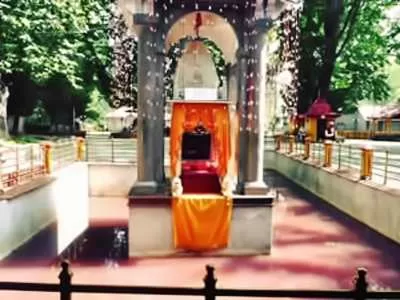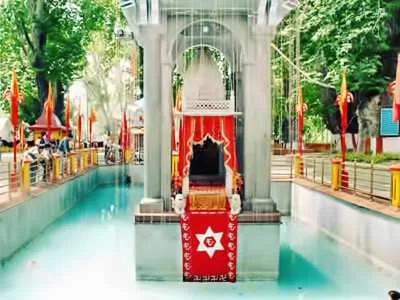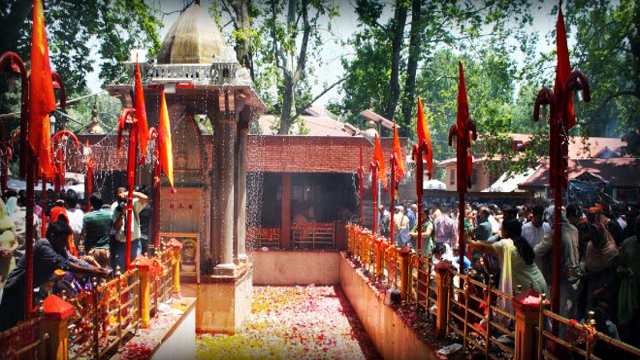The Kheer Bhawani Temple is located about 14 miles east of Srinagar in Kashmir, India. This temple is dedicated to the goddess Kheer Bhawani, whose name comes from a popular rice pudding called “kheer,” often offered at the temple. The goddess is known by many names, including Maharagya Devi and Ragnya Devi, and is considered an avatar of the goddess Durga.
The Legend of Kheer Bhawani
According to Hindu beliefs, Kheer Bhawani has a rich history. It is said that she appeared during the time of Ravana, the demon king from the epic Ramayana. Ravana was devoted to her and even built a temple for her in Sri Lanka. However, the goddess became unhappy with his wicked lifestyle and instructed Lord Hanuman to bring her image back to India. This image was then installed at the holy site of Tul Mull, where the Kheer Bhawani Temple now stands.
One of the most significant events at the temple is Zetha Ashtami, celebrated mainly in May. During this time, many Kashmiri Pandits, who have migrated worldwide, return to the temple to pay their respects.
The Mysterious Waters
What makes Kheer Bhawani famous is the water in the temple’s spring. Locals believe that the water changes color, turning red or black at rare times. These color changes are seen as ominous signs, often predicting bad events. For instance, the water turned red just before the devastating Kashmir floods in 2014, which resulted in the loss of over 200 lives and affected thousands more.

Historically, the water has changed colors before significant events. In 1886, Walter Lawrence, a British settlement commissioner, noted a violet hue in the spring. Locals also reported dark water before the assassination of Indira Gandhi and during the 1989 insurgency in Kashmir. Some even claim the water turned black before the exodus of Kashmiri Pandits in 1990.
Swami Vivekananda’s Experience
Swami Vivekananda, a prominent spiritual leader, visited Kheer Bhawani and claimed to have heard the voice of the goddess during a ritual. He described the spring’s unique septagonal shape and noted the water’s color changes, which he believed reflected the valley’s situation.
Scientific Explanations
While many believe the color changes are spiritual signs, science offers some explanations. The color of hot springs can be influenced by temperature and the presence of microbes. For example, in Yellowstone National Park, the Grand Prismatic Spring displays vibrant colors due to heat-loving microbes that thrive in different temperature zones.
As the water cools, different microbes can grow, leading to various colors. The center of the spring is the hottest, often appearing blue, while the cooler outer areas can show reds and oranges due to microbial mats.
The Connection to Kheer Bhawani
Could the same principles apply to Kheer Bhawani? The spring’s water may change color due to temperature variations and microbial activity. A study by Smithsonian noted that as you move away from the center of a hot spring, the temperature drops, allowing for a greater diversity of microbes. This could explain the color changes observed in Kheer Bhawani.

Human Impact on Color Changes
Interestingly, human activity can also affect the colors of hot springs. Research has shown that environmental changes can favor certain microbes, leading to shifts in color. For instance, pollution or debris can alter the temperature and microbial growth in a spring, changing its appearance.
In Kheer Bhawani, the water turned red shortly after Janmashtami, a significant Hindu festival. While no direct colorant was added, the accumulation of materials near the water source could have cooled the water, allowing microbes to thrive and change the color.
The Mystery of Black Water
The phenomenon of black water in hot springs is intriguing. Black water can result from the presence of sulfates and microorganisms that produce hydrogen sulfide (H2S). This chemical reaction can lead to the formation of ferrous sulfide, which gives the water a black appearance.
Kashmir is rich in minerals like borax and sulfur, which could contribute to these occurrences. The Steamboat Springs in Colorado, for example, are known for their black water, which is not dirty but rather a result of natural chemical processes.
Spiritual Significance
Many believe that the changing colors of Kheer Bhawani are tied to the spiritual state of the valley. For instance, the water turned red after a tragic event involving the Bavarian Orchestra in 2013, indicating a connection between the temple’s waters and the region’s emotional climate.
Conclusion
Kheer Bhawani Temple is a fascinating blend of spirituality and science. The changing colors of its waters have deep cultural significance for the people of Kashmir. While some view these changes as omens, scientific explanations suggest that temperature and microbial activity play a role.
As we explore the mysteries of Kheer Bhawani, we see how nature, culture, and spirituality intertwine. The temple remains a vital part of Kashmiri heritage, drawing visitors who seek to understand its significance. Whether through faith or science, Kheer Bhawani continues to captivate those who visit its sacred waters.

